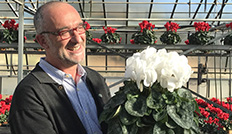 Professional area | Culture factsheet | Feeding | Physiology and nutrition
Professional area | Culture factsheet | Feeding | Physiology and nutrition
The nutrition of cyclamen depends first and foremost on climatic factors and the availability of oxygen and water to the roots. These variables lead to selectivity on the part of the root, altering the behaviour of the nutritional elements within the plant.
To assess whether plant tissue is functioning well or not, we must rely on a proper understanding of how it should work.
We arrive at a proper analysis by taking certain keys and using them to open the right doors in the right order.
What must be fully appreciated is the role of each key: that is, for each factor of productivity within the plant, its role in the plant’s workings must be understood.
Plant life is such that some factors are more quickly “limiting” than others. It is useless, for instance, to seek to concentrate on balanced nutrition when the primary factors - light, air, heat, and water - are still limiting.

Example :
As it respires, the root actively assimilates nutrients.
Where there is inadequate respiration due to insufficient partial pressure in oxygen, the assimilation mechanisms become passive. The root can no longer actively combat the assimilation of "toxins".
Either the root is poisoned, or it sets about forming protective "barriers", known as "scorches", preventing excessive penetration of nutrients which cannot be metabolised because respiration has stopped.
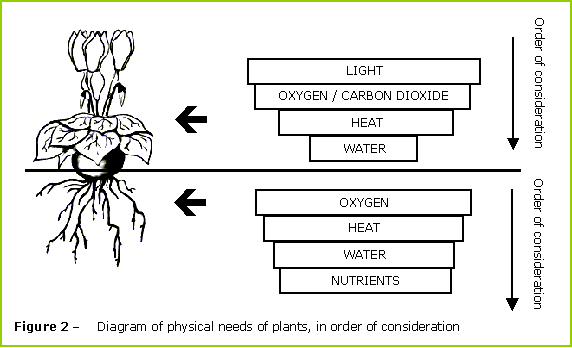
Light is the first factor necessary for plant life. What it provides is the energy needed for the plant’s engine to run.
Oxygen and carbon dioxide constitute the second factor of productivity, after light.
These form the very basis of the plant matter itself, which is mainly composed of :
|
: |
C, from CO2 (carbon dioxide) |
|
: |
O, from O2 (oxygen) |
|
: |
H, water H2O (water) |
Contrary to general imagination, oxygen is a limiting factor before water, so far as the roots are concerned. The machinery of the cyclamen’s plant tissue is in fact based on a series of reactions which are predominantly oxidation ones.
The root, in the presence of an adequate partial pressure in oxygen, develops active assimilation mechanisms. It is then able to select the nutrients it needs and transfer them in an active manner to the right organs.
If the roots’ oxygen requirements are not met, then the root develops, temporarily, reactions of a "passive" nature, mainly reducing ones.
These passive reactions are "compensatory", while waiting for the return of conditions in which oxygen is no longer limiting.
These passive reactions are harmful, in that the cyclamen becomes poisoned. The plant can no longer “actively” control its nutrition.
Among other substances taken up in this situation are ammonium nitrate, aluminium, and manganese.
The root is penetrated passively by these “reduced” substances. It can no longer carry on its normal oxidating activity, and there is a build-up of these reduced substances, which of course are toxic to it. Malformations appear on the leaves, and prick-marks on the flowers as well (a sign of excess manganese). In the end the cyclamen has recourse to its "anti-poison" defences by developing corky bodies on the roots as a defensive barrier.
At this stage there is a loss of roots.
These passive phenomena end once the oxygen partial pressure comes back to normal. The toxic substances taken in are then oxidised and in this way "neutralised".
But in addition to the overall quantity, what is important here above all is the notion of the "rate of flow" of oxygen.
Everything depends on how quickly the "normal" oxygen level is reached.
This notion, of the rate of renewal of oxygen, will prove one of the key elements in a choice of growing medium.
It should also be noted that all "oxidising" activity in the root produces an element of "reduction" in the immediate neighbourhood.
In other words, when the root respires and consumes oxygen in solution, it also gives off carbon dioxide (CO2).
This is why the ideas of flow and circulation of gases are of primary importance where roots are concerned.
The increase in the partial pressure of carbon dioxide (respiratory waste product) around the roots takes place at the expense of the partial pressure of oxygen.
The only means of keeping an adequate pressure of oxygen is to “drive off" the carbon dioxide.
This "driving off" is for the most part achieved by means of water circulation.
As a result, it is no use giving a drink to a plant which is cold; still less use giving it food; and it can even be dangerous.
NB: the combination of watering+medium, in determining above all the oxygen partial pressure available to the roots, determines also the "heat" which is provided to them.
Example :
The case of rose cuttings grown on fine peaty mediums with little coarse fibre; watering with unwarmed, cool water - winter season.
Any watering which provides a conductivity of more than 1.5 mS/cm produces burns on the roots.
The limiting factor here is the heat provided to the roots.
The medium used has inadequate heat mass. The warm "air" does not circulate enough, since the medium stays water-saturated too long.
This lowers the threshold of the root’s tolerance to conductivity.
Water and nutrients = fourth factor of productivity.
Once the first three factors are sufficient, then and only then can the cyclamen feed!
The main feature of water-borne nutrition is the fact that it is above all a nutrition of transit.
What this means is that far more water enters through the roots, and is given off into the atmosphere by transpiration of the above-ground organs, than the cyclamen contains at any given moment.
Mineral nutrition is that involving all the elements other than C, O, and H.
It is characterised by a more or less complete incorporation of these nutrients into the tissues of the cyclamen.
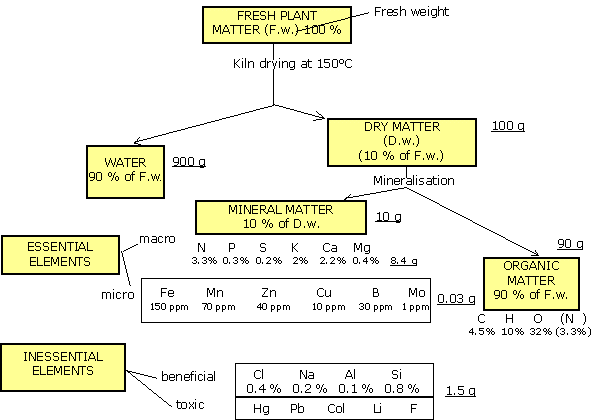
Mineral substances are in general absorbed in the form of ions, products of decomposition of mineral salts (fertiliser) in water into electrolytes.
There are other molecules, as well as ions, which may be assimilated:
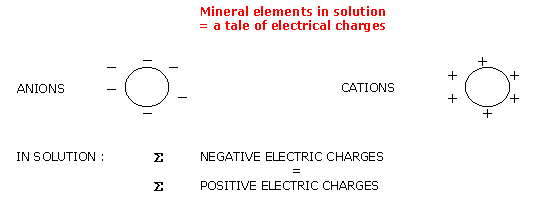
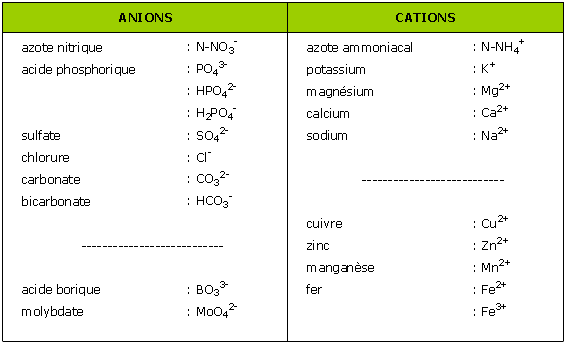
In solution, the sum of the negative electric charges is always equal to the sum of the positive electric charges.
The organs of absorption consist of the roots as a whole, sometimes the leaves, and occasionally the fruit or stem.
We consider that foliar feeding can never be regarded as a permanent avenue of nutrition. It should only be contemplated within a context of preventive dusting (for instance, just before certain quite definite stages), or as "first aid". It is therefore a momentary adjustment of imbalances, but can never provide a plant with the whole of its needs.
On the contrary, it is the absorbent hairs of the young roots (root hairs) which provide the main avenue of absorption both of water and of mineral elements.
Absorption is in fact for the most part governed by the existence of barriers within the cyclamen.
The root hair has an extremely fine membrane, which allows ready diffusion of elements.
Take care ! Not all root hairs are the same !
The cyclamen is sometimes obliged to grow very long, immature roots, which have a tendency to curl or corkscrew. These roots are seeking to make contact with the medium, and not finding it; and the plant goes on extending this root until contact is restored.
(This happens with a porosity of a very coarse medium).
These roots are immature, not suberised; in no instance do they count as "long" root hairs.
An active root is characterised by no more than two or three centimetres of length that is effective in terms of "absorptive capacity".
Watch out also for roots which show suberised bases (corky aspect, somewhat thickened). These bases are a major barrier to absorption. The "absorptive capacity" of these roots is reduced accordingly.
The cyclamen, like all bulb species, is classified as a "demanding" plant in terms of its feeding requirements.
Bulb plants are in fact some of the weakest at extraction of nutrients.
Also, the bulbs and their root systems combine two opposing characteristics in the one plant: they have a high oxygen demand, but do not tolerate an over-coarse medium, which limits the contact between root or bulb and medium, and so makes it harder for the root to extract nutrients such as phosphorus and trace elements.
There are many cases of malnutrition of cyclamen in summer: deficiencies in boron, manganese, and iron. These are attributable, among other things, to insufficient contact between the root and the growing medium.
This weak extractive power of the cyclamen’s root system means that it is classified as a demanding species, so far as trace elements are concerned
Example :
Phosphate nutrition is entirely a matter of the cyclamen’s ability to renew its root hairs.
Studies have shown that it is only the root hairs which can take up phosphorus present in the environment ; this includes hairs at the earliest stages of root formation. Only that proportion of phosphorus which is water -soluble can therefore be assimilated.
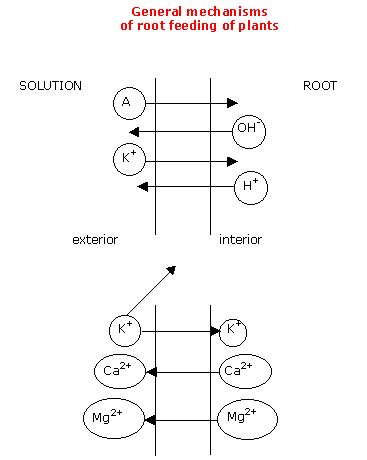
Any increase in the amount of one of the substances in the neighbourhood of the root or of the medium causes a greater fixation or additional absorption of that substance at the expense of the others, even if their concentrations are no less than before !
Adsorption, the phenomenon in which solids or solutions retain on their surfaces molecules or ions in the gaseous or liquid state, is not to be confused with absorption, a property displayed by solids or liquids when retaining certain gases or liquids within the whole of their volume.
Cell membranes, particularly, are rich in negative electric poles. This gives them a root CEC, i.e. a Cation Exchange Capacity, or a capacity for fixing solution cations (positive ions).
Cations in the environment are adsorbed onto this root CEC and exchanged for cations from within the cell, which are accordingly given off into the environment (see diagram).
This happens to the cations K+ (potassium), Ca2+ (calcium), Mg2+ (magnesium), Na+ (sodium), NH4+ (ammonium).
For trace elements, the mechanism is different.
Trace elements are seldom present in the form of ions in the solution. Most often they are "chelated" on organic matter in small organic chelates.
Therefore they can only be assimilated by the root, of course, if the root hair is in physical contact with the growing medium (earth or special mediums,...). This contact between organic chelate and CEC (negative poles) of the root hair allows it to absorb and fix the trace element. (Cu2+, Mn2+, Zn2+, Fe2+).
Adsorption and absorption are passive mechanisms. The plant expends no energy.
In order to carry out absorption beyond the free space of the roots, the plant uses active mechanisms: this is metabolic pumping.
This stage allows nutrients to penetrate in inverse ratio to their concentration gradient.
This stage consumes large quantities of energy, supplied by respiration.
But all respiration requires oxygen, whether it takes place above ground or among the roots!
That is the reason why an "asphyxiated" cyclamen cannot feed.
Cyclamen select from among the mineral elements. This root selectivity in plants works according to two principles :

Here it should be noted that potassium and sodium ions are more or less the same size; sodium can therefore quite easily replace potassium.
|
Ca2+ |
> |
Mg2+ |
> |
K+ |
> |
Na+ |
> |
H+ |
The combination of these two principles gives us an effective ordering of rates of cross-membrane transfer, as follows :

NB : potassium and nitrate cross membranes very quickly, the one as readily as the other, which is why potassium is useful for neutralising "nitrogen".
As soon as a nitrogen deficiency appears, the root selects the anion which penetrates most quickly, next to nitrate, i.e. chlorides.
Care must therefore be taken to avoid nitric nitrogen deficiencies in chloride-rich environments.
Magnesium and calcium are large cations which diffuse less readily within the root, especially when the root is under some form of stress.
Phosphates do not cross membranes at all readily, so it is necessary to have a good large mass of root hairs to compensate for poor uptake by each root.
The composition of cyclamen will also vary depending on the kind of environment it grows in; the rate of uptake of each nutrient will depend, among other things, on the concentration of the relevant ion in the environment.
The mere presence, even widespread presence, of an element in the cyclamen’s natural environment does not mean that it is indispensable to the cyclamen’s life: and absorption is not an intelligent business. There are certain regulatory mechanisms, but the cyclamen is nevertheless only able to reject certain substances which are inherently harmful, and others that become so in excess, under certain conditions and up to a certain limit.
We may distinguish :
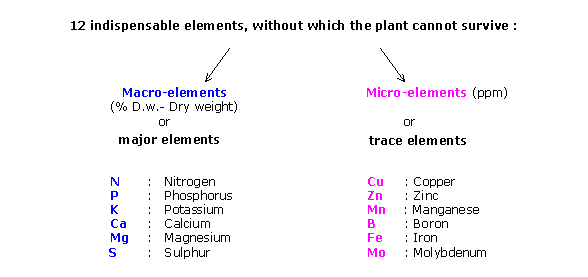
NB : the notion of toxicity is an arbitrary one, if removed from its agronomic context.
Toxicity is, of course, a matter of excess; but the interpretation of visible symptoms is always highly debatable.
Nitrogen is the principal factor in stem and leaf growth.
Phosphorus, when soluble in water, encourages the development of the root hairs, but does not itself "generate" roots, in the strict sense.
Only a small proportion of the phosphorus present in the environment need be in the form of water-soluble phosphates (H2PO4) for the young root hair to be able to take it up.
This phosphorus then becomes part of the cell’s functioning in the form of ATP (an energy-rich molecule).
This stored energy allows the young roots to continue the growth they have started.
The quantity of phosphorus supplied, then, should not be confused with the form of phosphorus in the environment! When the roots are very young they deliver very small amounts of phosphorus, of course; but this phosphorus must be immediately available (hence the idea of solubility of the various forms of phosphate).
Why this position of "master cation"? What makes this cation the main means of controlling the quality of plant tissue?
Potassium is taken up preferentially, and for that reason is easily diffused and has good selectivity.
Any potash provided is taken up, even in the form of "luxury consumption”, because there is virtually no brake on its assimilation; this can lead to poor activation of the respiration coefficient, and may tire the cyclamen.
Potassium also has some exceptionally wide-ranging roles.
Proportions found most often in cyclamen are similar to those of nitrogen, and often even higher.
Living matter always produces a predominance of negatively charged products - acid or acidic-type radicals, produced by metabolism - in the course of its functioning.
Potassium is often the only cation capable of making its way into cells to neutralise these acid (negative) radicals as they are synthesised.
This is why we say potassium "fosters” photosynthesis and stimulates respiration, in this way encouraging the formation of reserves.
Since potassium is highly soluble, it is the main cation influencing cell osmotic pressure.
The more potassium concentrates in the cell vacuoles, the higher the osmotic pressure, and the more the cyclamen takes in water through its roots to "dilute" this concentration of potassium in the cell.
Hence its role as stimulator of water absorption.
Improvement of water retention by plant tissue encourages frost resistance and resistance to certain diseases.
But potassium also averts waste of water in other ways.
The most important of these is its involvement in the movement of the stomata (little pores opening in the leaves which can open or close, and regulate transpiration).
What potassium does is to shorten the period during which the opening of the stomata is not adapted to suit the environmental conditions.
This is how potassium is involved in the cyclamen’s resistance to summer drought.
Potassium activates a great number of enzymes, and encourages the synthesis of polymer compounds.
As a result, potassium influences the synthesis of the pigments responsible for the colouring of the flowers.
Essentially it is the beneficial effect of potassium on the movement of sugars that has turned out to be most important.
From this comes its role in the activation of the process whereby the cyclamen stores its reserves in the bulb.
The role of feeding, then, is to provide a sufficient partial pressure of potassium to the roots, approximately 15 days before whatever effect is to be produced.
Calcium plays a constructional role, since it is an integral part of pecto-cellulose cell walls.
It also plays an antitoxic role: it neutralises acidic ions within substructures (sulphates, carbonates, ...).
Calcium does not move easily within the plant.
It counterbalances the influence of potassium.
Potassium can, in fact, be toxic for the plant, by over-encouraging cell permeability. Calcium counterbalances this influence, lowering this permeability.
From this we derive the notion of a K / Ca opposition. It should be noted that this K/Ca opposition is essentially a function of the cyclamen’s water economy. Watering seldom and in large amounts encourages the take-up of potassium, while watering little and often encourages take-up of calcium, and even of magnesium.
The chlorophyll molecule contains a magnesium atom.
It encourages early flowering.
Beware confusions!
A proper distinction must be made between what we learn from plant physiology and what the environment is capable of providing.
K and Ca levels, in an analysis of the growth medium or soil, have to be interpreted in K/Ca terms, not because there is a physiological opposition between K and Ca, or between K and Mg.
For in growing mediums, which in most cases have normal supplies of calcium and magnesium, the assimilation of the 3 cations (K, Ca and Mg) is regulated, not by these relations of opposition, but by the levels of hydration and of the respiration coefficient.

When A increases in the environment and B remains constant, the absorption of A increases, but that of B goes down.

Magnesium presents an "intermediate" behaviour between that of K and that of Ca. In organic mediums, magnesium deficiency is most often caused by defective physical structure or deficient environmental aeration, which results in poor magnesium uptake. Potassium concentration in the environment has virtually no influence.

When the concentration of element A increases in solution and the concentration of element B remains constant, element A increases the plant’s uptake of element B.
We give here two essential synergies:
This synergy is of particular benefit in spring, when the soil or growing medium is cool. Supplying phosphates and nitrogen together encourages uptake of the phosphorus in the earliest stages of root formation.
This synergy only works if a portion of the phosphates is soluble in water.
This is the basis of giving fertiliser of the ammonium phosphate type.
Giving magnesia stimulates the absorption of phosphorus.
In a limiting situation, such as for instance following root loss, giving magnesia encourages the uptake of phosphorus, which the stressed root system is otherwise not capable of assimilating effectively. The feeding avoids leaf fall, and encourages the activation of the root cells.
Feeding needs to make available a supply which, given the factors which affect nutrition, brings about a situation in which the cyclamen can meet its internal needs.
These internal needs are a matter of what the plant “exports”.
But it is not enough simply to know the quantities the plant is exporting.
Enhancement coefficients need to be factored in, and these depend on the environment, among other things.
2565, rue de Montourey
83600 Fréjus - France
International telephone : +33 (0)4 94 19 73 04
Switchboard : + 33 (0)4 94 19 73 00
Fax : +33 (0)4 94 19 73 19

